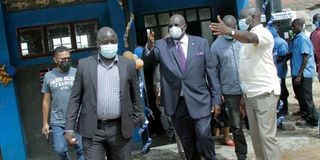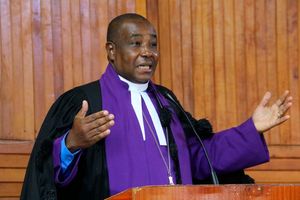Premium
Why transition to junior high remains a headache

Education Cabinet Secretary Prof George Magoha with other education officials at Allidina Visram High School in Mombasa when he officially opened a new Competency Based Curriculum (CBC) classroom which will host the Junior Secondary School Students in this photo taken on February 6, 2022.
Uncertainty is stalking the implementation of junior secondary under the competency-based curriculum (CBC), causing worry among parents, teachers and other education stakeholders.
Concerns have centred around the content, domiciling, infrastructure, funding and placement in the new level of education to be rolled out in secondary schools in January next year.
Education Cabinet Secretary George Magoha had to come out on Wednesday last week to clarify that junior secondary will be in both boarding and day schools.
He was reacting to earlier comments by senior officials, including Government Spokesman Cyrus Oguna, that junior secondary will only be offered in day schools and learners will only be admitted to boarding schools in senior secondary. “All the existing boarding and day secondary schools will admit learners transiting from Grade 6 to Grade 7 under CBC based on guidelines to be provided by the Ministry,” Prof Magoha corrected in a statement.
Under the CBC, junior secondary comprises Grade 7, 8 and 9, after which learners will transit to senior secondary (Grade 10,11 and 12). University study time has been reduced from four to three years. Additionally, Prof Magoha said the ministry has identified 1,500 primary schools that will host junior secondary, saying the institutions have adequate learning and teaching facilities and land for physical expansion.
However, there still exists gaps in the plan that remain unaddressed. Congestion in public secondary schools has remained a concern in recent years. The primary schools mentioned by Prof Magoha have also remained a secret, despite only six months remaining before the transition.
According to data contained in the report by the taskforce that Prof Magoha appointed to advise on the CBC implementation, 1,250,649 learners in the pioneer CBC class are projected to transition to Grade 7 alongside 1,320,395 others who will be joining Form One under the 8-4-4, totalling 2,571,044 new learners.
This is bound to exert pressure on the already stretched facilities in secondary schools. The scheduled double intakes in 2023 and 2024 as the last two 8-4-4 classes exit primary school will push enrolment from 4,381,701 to 6,029,168 in the first year, and to 7,649,943 the following year.
Based on data collected by the taskforce, there will be a shortfall of 1,489,144 places in secondary schools next year. It is this gap that the government has been trying to close with the construction of 10,000 classrooms. So far, over 6,000 have been completed.
The project was launched late last year and the Jubilee administration has only two-and-a-half months left to construct the rest.
“The anticipated enrolment increase will also require expansion of laboratories, libraries, wash facilities and related resources. Effective transition, therefore, calls for nationwide and local context-specific planning to ensure all learners are equitably placed,” the report reads.
Worryingly, none of the 47 counties has adequate spaces in secondary schools for the combined 2.5 million learners exiting Grade 6 and Standard 8 in November. Kakamega leads with the shortage of spaces at 93,703, followed by Bungoma (83,243) and Nairobi (83,062). Lamu has the least at 4,634, followed by Isiolo at 6,338 and Taita Taveta (6,897).
Aware of the problem at hand, the government has been encouraging private schools, especially those in urban areas, to set up stand-alone junior secondary sections to provide more spaces. A few of them are already establishing junior high wings. Enrolment in the 1,301 private secondary schools stands at 203,448 as per the latest official data.
The ministry has not yet issued guidelines for placement, but the Nation understands they will be released once finalised. The thinking behind enrolling more learners in day schools is guided by the fact that there are 6,776 sub-county schools as compared to 1,378 county, 776 extra-county and 112 national schools.
“Enrolment in day schools has been affected by the misconception that their learners do not attain good grades in national examinations. This is not factual as confirmed by data on KCSE exam results,” the taskforce noted.
Whereas the Kenya National Examinations Council (Knec) has come up with the competency-based assessment framework, the ministry has yet to guide on how results will be used for placement in various categories of schools. Learners will attain 60 per cent of their final grade from formative assessments at the end of Grade 4, 5 and 6. The final 40 will be from a summative assessment at the end of Grade 6—the first such to be administered in November by the name Kenya Primary School Education Assessment (KPSEA), effectively replacing KCPE. Registration of candidates for the test closed yesterday. The formative assessments are school-based, administered and scored by teachers, but the summative one will be administered and marked by Knec.
Competition is usually high for the few places in top-performing national and extra-county schools, which are better equipped and staffed than the county and sub-county schools.
“With the culture of cheating in exams so entrenched in our schools, we, in public schools, fear that our colleagues in private schools might favour their learners as good performance of their learners translates into good business,” a teacher said.
Some stakeholders warn that the problems facing CBC are more to do with implementation than the curriculum itself. “There is no difference with the original 8-4-4 template, which was not implemented as envisaged. CBC will arguably go the 8-4-4 way because of poor implementation and the fact that it's very expensive,” said Enock Matundura, a lecturer at Chuka University.
Another sticking point is that the 2022/23 Budget presented by Treasury Cabinet Secretary Ukur Yatani increased the allocation for the free day secondary education programme from Sh62.2 million to Sh64.4 billion only, despite the huge increase of learners. At Sh22,224 annual capitation per learner, at least Sh27 billion ought to have been allocated. Some learners will, however, go to private schools, hence will need no government support.
Finally, secondary schools face a teacher shortage crisis that has persisted for years. Also of concern is that more teachers are exiting the service than the government can replace.





